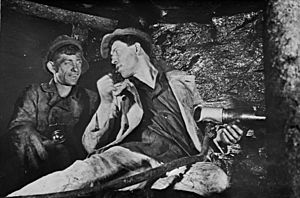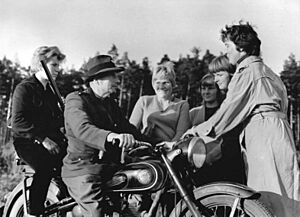Stakhanovite movement facts for kids

The Stakhanovite movement was a big movement of workers in the Soviet Union. It encouraged people to work harder and smarter. Workers aimed to produce much more than expected. They wanted to help their country and make it stronger. The movement was named after Alexei Stakhanov, a coal miner. Stakhanovites were proud to work very efficiently. This movement started in coal mines. Soon, it spread to many other jobs across the Soviet Union. At first, it was very popular. But over time, some workers found it difficult. This was because higher production meant more demands on them.
Contents
How the Stakhanovite Movement Started
The Stakhanovite movement began in 1935. This was during the Soviet Union's second five-year plan. It was a new step in a type of competition called "socialist competition." This competition followed a time of fast industrial growth.
The movement got its name from Aleksei Grigorievich Stakhanov. He was a coal miner. On August 31, 1935, he reportedly mined 102 tons of coal. He did this in less than 6 hours. This was 14 times more than his usual goal! Soon, other Stakhanovite workers broke his record. For example, on February 1, 1936, Nikita Izotov mined 640 tons of coal in one shift.
Spreading the Idea of Hard Work
The Communist Party strongly supported the Stakhanovite movement. It quickly spread to many other industries. These included car making, shoe production, and textile factories. It also reached machine tools, timber, and railroads. Even farming had Stakhanovites. Famous pioneers included Alexander Busygin, Nikolai Smetanin, and the Vinogradova sisters. Pasha Angelina was a well-known female Stakhanovite in agriculture.
From November 14 to 17, 1935, a big meeting took place. It was the 1st All-Union Stakhanovite Conference. It happened at the Kremlin. The conference highlighted how important the movement was. It showed how it helped rebuild the country's economy. In December 1935, the Communist Party's Central Committee discussed the movement. They talked about how to develop industries and transport systems.
Following these discussions, the Soviets set up many training programs. They created special courses for workers. In 1936, many industrial meetings happened. They looked at how much different industries could produce. They then increased these production goals. They also started Stakhanovite contests. These contests found the best workers. They also encouraged competition among them.
Women in the Movement
Fewer women became Stakhanovites than men. However, about a quarter of all women in trade unions were called "norm-breaking." This meant they produced more than their set goals. Many women Stakhanovites worked in the countryside. They worked as milkmaids, calf tenders, or fieldworkers.
The Soviet leaders said the Stakhanovite movement greatly increased how much work got done. They reported that during the first five-year plan (1928–32), industrial work increased by 41%. During the second five-year plan (1933–1937), it reportedly increased by 82%.

During World War II, Stakhanovites found new ways to produce more. They would operate several machines at once. They also combined different jobs. Some Stakhanovites started the "two-hundreders movement." This meant they produced 200% or more of their goal in one shift.
Challenges and End of the Movement
Not everyone liked the Stakhanovite movement. Some workers felt it made their lives harder. They even threatened Stakhanov himself. People who opposed the movement were sometimes called "wreckers."
In 1988, a Soviet newspaper called Komsomolskaya Pravda said that Stakhanov's famous achievements were exaggerated. The paper claimed Stakhanov had many helpers. But the high production numbers were only counted for him. The Soviet state media later said Stakhanov's method did increase production. This was because it organized work better. It used specialization and planned tasks in a sequence.
In Fiction
- Yuri Krymov's 1938 novel Tanker "Derbent" is about Stakhanovitism. It focuses on oil transport across the Caspian Sea. A film was also made based on it in 1941.
- Andrzej Wajda's film Man of Marble looks at how a fictional Polish Stakhanovite became a legend. It tells the story of his rise and fall.
- George Orwell's novel Animal Farm has a character like a Stakhanovite. This is Boxer the Horse. His motto is "I will work harder!"
- Harry Turtledove's novel Fallout includes a character who works very hard. He works like a Stakhanovite. This causes problems with other people in his town.
- Grigori Aleksandrov's film Tanya is about a female character. She becomes part of the Stakhanovite movement.
See also
- 996 working hour system
- Model worker
- Cherkasova movement
- Chollima movement
- Family in the Soviet Union
- Gaganova movement
- Izotovite movement
- Lunin movement
- Shturmovshchina
- Udarnik
- Vinogradova movement


